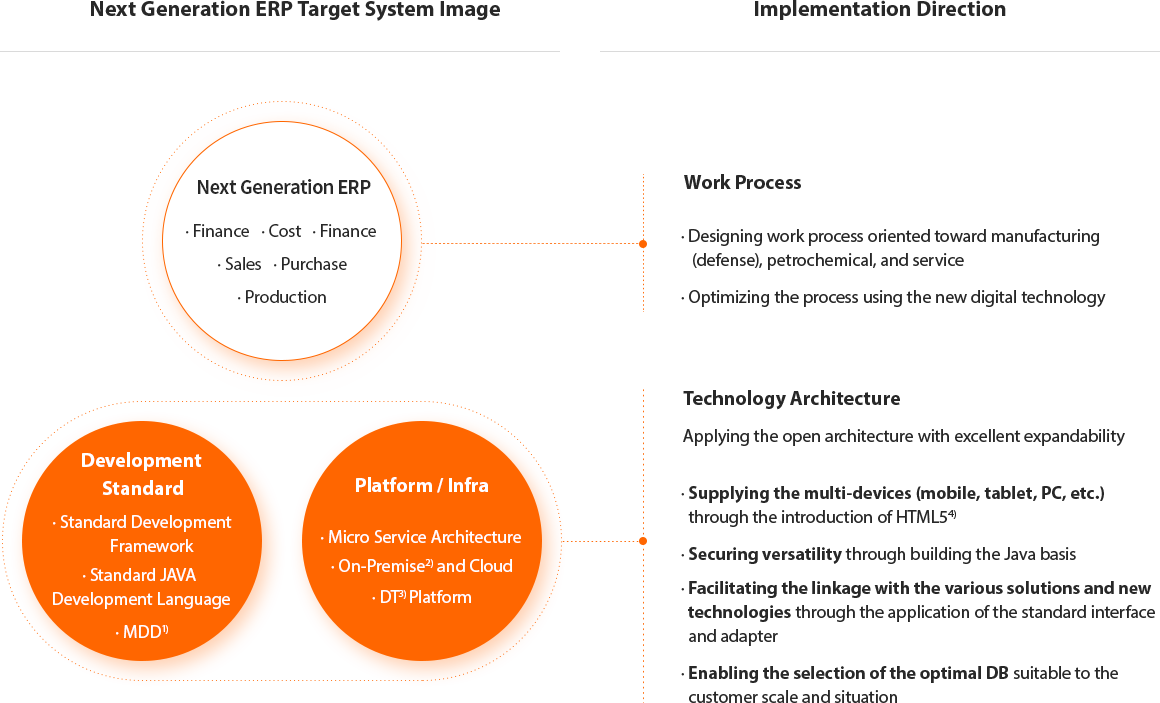Solution
Hanwha Systems provides the optimal IT solution preemptively responding to the rapidly changing market environment.


Business efficiency can be enhanced through
flexibility in dynamic business environment.
The Next Generation ERP of Hanwha Systems is the optimal business management system of
Hanwha Group to flexibly handle the fast changing business environment and to enhance the business efficiency.
Features
-
OptimizationERP optimized
for the customer business- The core reflecting the industrial characteristics (manufacturing (defense)/petrochemical/service)
- Composition oriented toward the 6 kinds of work (accounting, cost, finance, sales, purchase, and production) having the high utilization importance
- Mounting the solution by standardizing the representative work in the group such as manufacturing and petrochemical
- Making the composition with the selective selection for the additional necessary work
-
FlexibilityERP responding to the business environment and the external requirements promptly
- Building the faster and more flexible system by applying the business API and set-up method
- Providing the data transfer tool for the fast and correct system integration and separation
-
ExpandabilityERP reflecting expandability in linkage with another technology
- ERP possibly and organically combined with the advanced IT technology and another solution
- Oriented toward the open architecture and the Micro Service Architecture (MSA)
Target System
Next Generation ERP provides the 6 kinds of work (accounting, cost, finance, sales, purchase, and production) oriented toward the manufacturing (defense), petrochemical, and service industry group. Especially, the process is optimized by using the advanced new IT technology with the area expanded more through the open architecture.

- Next Generation ERP Target System diagram
-
Next Generation ERP
- Finance
- Cost
- Finance
- Sales
- Purchase
- Production
-
Development Standard
- Standard Development Framework
- Standard JAVA Development Language
- MDD1)
-
Platform / Infra
- Micro Service Architecture
- On-Premise2) and Cloud
- DT3) Platform
- Implementation Direction
-
Next Generation ERP Implementation Direction
Work Process
- Designing work process oriented toward manufacturing (defense), petrochemical, and service
- Optimizing the process using the new digital technology
-
Development Standard, Platform / Infra Implementation direction
Technology Architecture
Applying the open architecture with excellent expandability
- Supplying the multi-devices (mobile, tablet, PC, etc.) through the introduction of HTML54)
- Securing versatility through building the Java basis
- Facilitating the linkage with the various solutions and new technologies through the application of the standard interface and adapter
- Enabling the selection of the optimal DB suitable to the customer scale and situation
- 1) Model Driven Development: The S/W development method of doing the analysis and design oriented toward the design model and of automatically generating the source code and output
- 2) The method of directly installed and operated in the computer center possessed internally and the general method of building the corporate infra before the advent of the cloud technology
- 3) Digital Transformation: The overall corporate business innovation activity basically changing the strategy, the organization, the product and service, the process, and the system by using the corporate digital competence
- 4) HTML(Hypertext markup language): The latest programming language used for producing the web document
Next Generation ERP Target System diagram
Next
Generation
ERP
- Finance
- Cost
- Finance
- Sales
- Purchase
- Production
Work Process
- Designing work process oriented toward manufacturing (defense), petrochemical, and service
- Optimizing the process using the new digital technology
Development Standard
- Standard Development
Framework - Standard JAVA Development Language
- MDD1)
Platform / Infra
- Micro Service Architecture
- On-premise2) and cloud
- DT3) Platform
Technology Architecture
Applying the open architecture with excellent expandability
- Supplying the multi-devices (mobile, tablet, PC, etc.) through the introduction of HTML54)
- Securing versatility through building the Java basis
- Facilitating the linkage with the various solutions and new technologies through the application of the standard interface and adapter
- Enabling the selection of the optimal DB suitable to the customer scale and situation
- 1) Model Driven Development: The S/W development method of doing the analysis and design oriented toward the design model and of automatically generating the source code and output
- 2) The method of directly installed and operated in the computer center possessed internally and the general method of building the corporate infra before the advent of the cloud technology
- 3) Digital Transformation: The overall corporate business innovation activity basically changing the strategy, the organization, the product and service, the process, and the system by using the corporate digital competence
- 4) HTML(Hypertext markup language): The latest programming language used for producing the web document
Expected Effects
- Securing the competitiveness as the IT company by getting the advanced solution and technological prowessChange from the vendor solution sales company to the company of building and selling the internal solution
- Securing the bridge for entering the local ERP marketExpanding the external sales portion with the local large and medium-sized companies’ entering the ERP market
- Entering the internal and external markets and increasing sales with the expansion of the solution-based business
- Reducing the fixed cost and securing the business competitiveness




